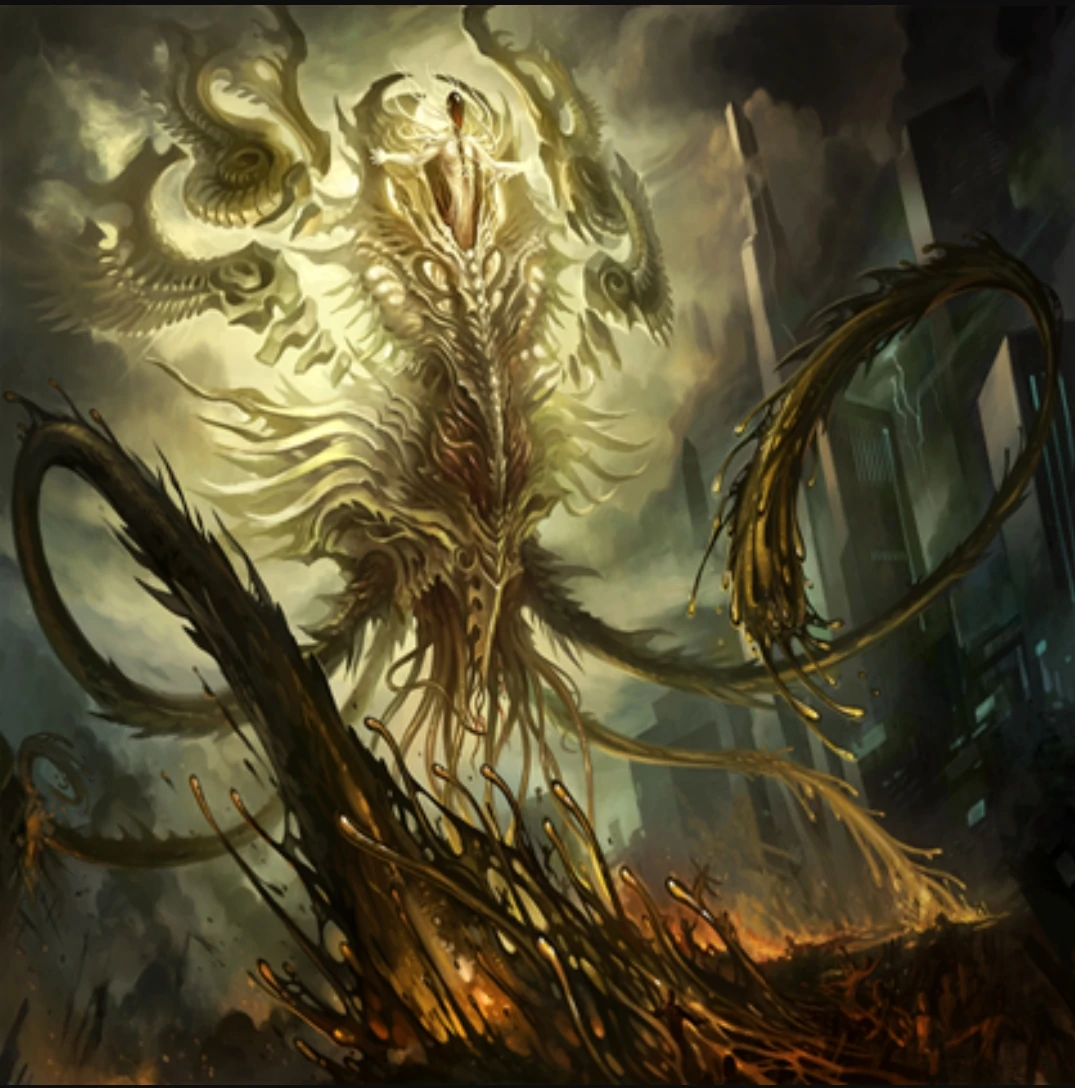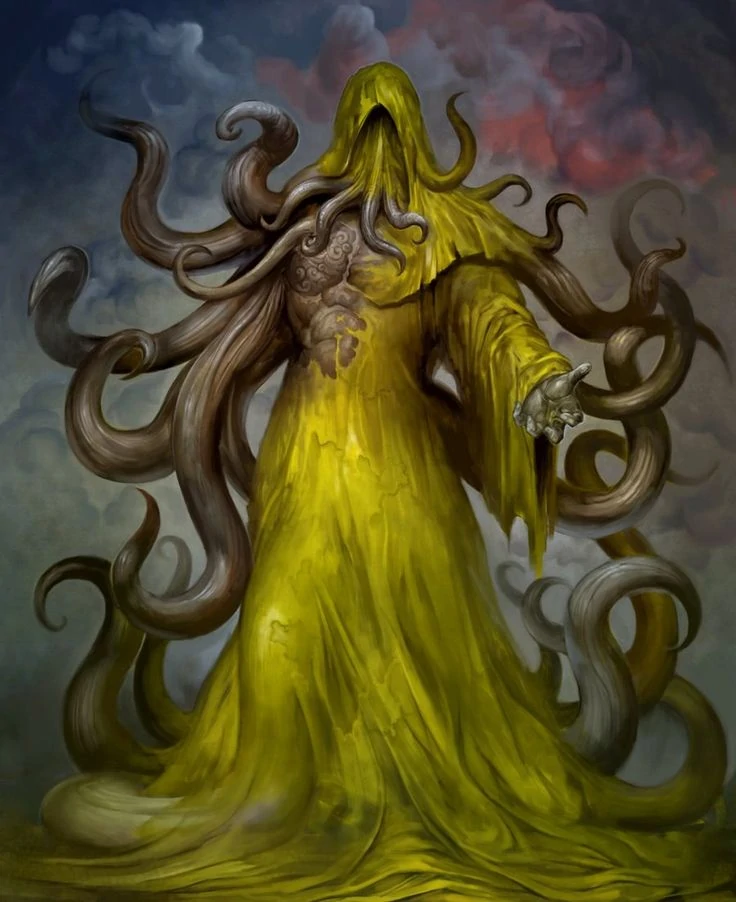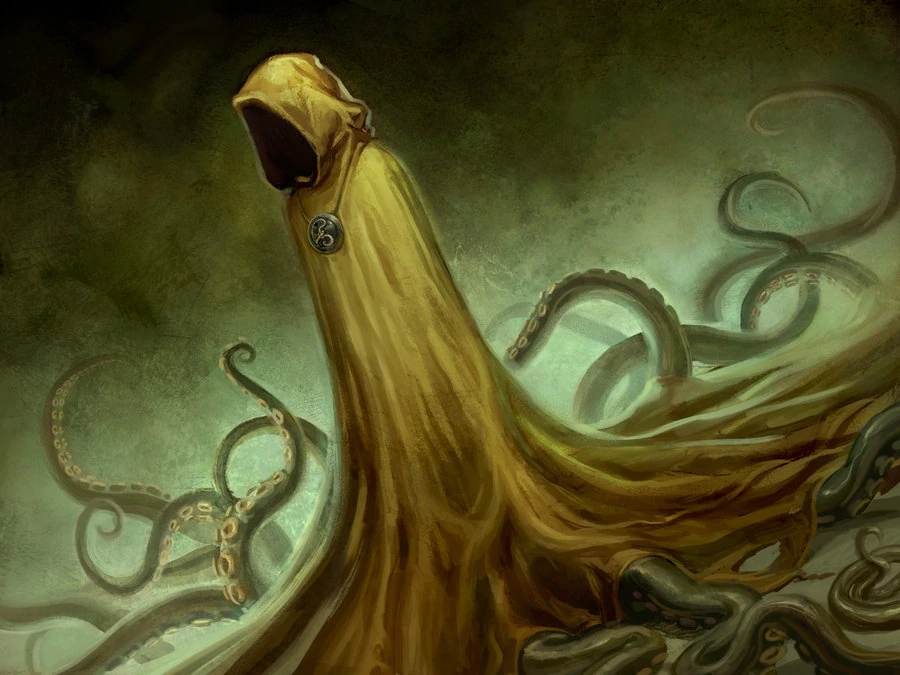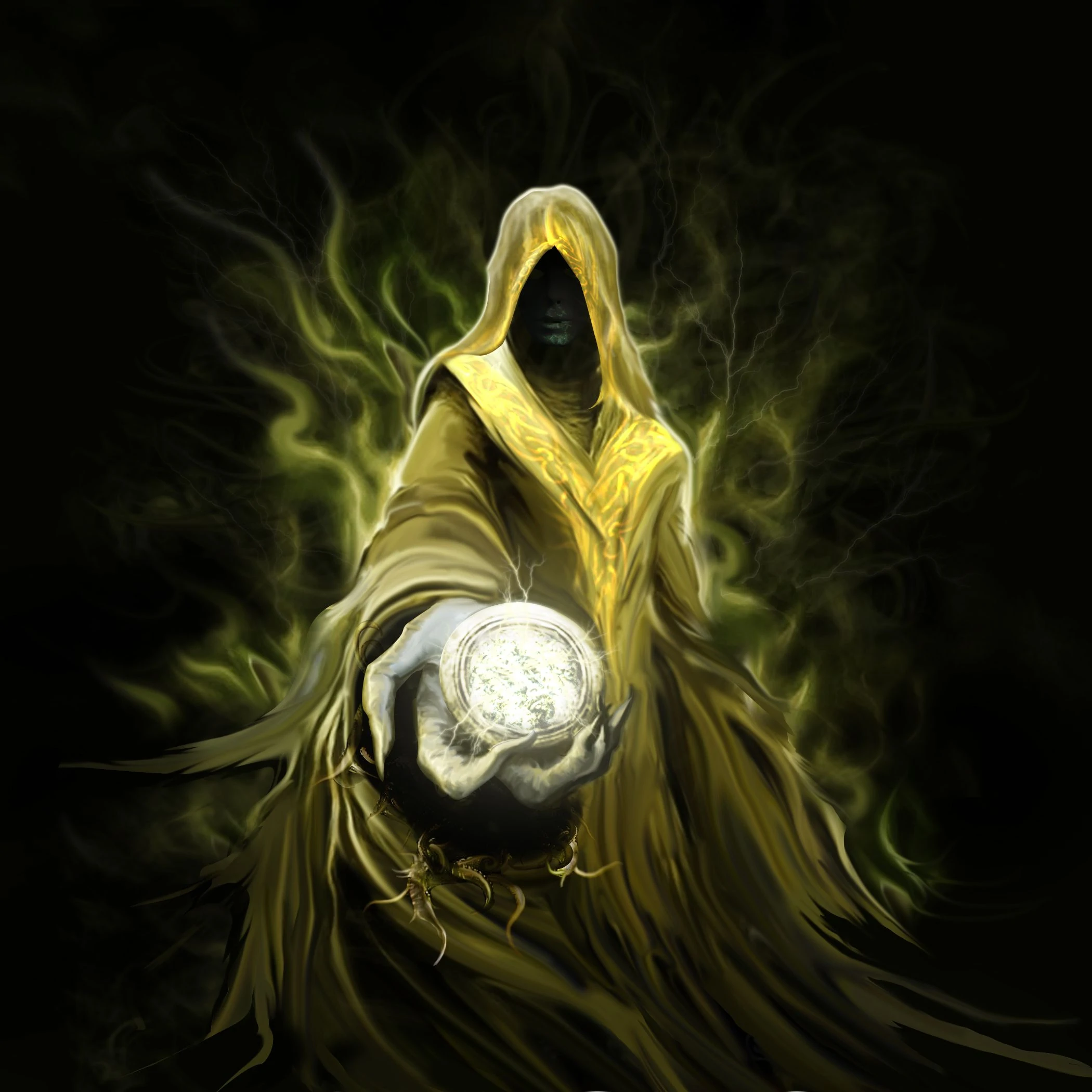H.P. Lovecraft, known as the “Father of Horror,” is renowned for having a fantastical yet terrible imagination. He concocted and envisioned a slew of unimaginable horrors that have now become horror standards. The Cthulu mythos, in particular, is a body of work with a strong cult following that continues to enjoy tremendous appeal today.
We strive to explain numerous Lovecraftian concepts on our channel, and today we present you Hastur, the King in Yellow. The Cthulhu mythos’ Hastur the Unspeakable is a Cthulhu deity. The creature is only referenced in one of H. P. Lovecraft’s stories, “The Whisperer in Darkness.” despite its link with him. It was first conceived by Ambrose Bierce. In a poem, Ambrose Bierce was the first to use the word Hastur.
Beirce was the creator of Hastur, the shepherd god. RW Chambers took the word, along with a few others like “Carcosa,” from Bierce and used it in The Yellow Sign, one of the best strange stories ever written. Hastur is a planet in the Chambers story, and Carcosa is a city or fortification on Lake Hali’s “cloud beaches.” There are also huge octopoid forms in the lake. However, as we will see in this movie, Hastur’s image shifts from city to deity.
In the same story, the King in Yellow, king of Carcosa and wearer of the Palid Mask, is mentioned. Around 20 years after the publication of The Yellow Sign, Lovecraft mentioned Hastur in passing in his story The Whisperer in the Darkness, alongside a deity named Shub-Niggurath. Cthulhu’s hated sibling, is an octopoid beast. In most depictions, he resembles an octopus rather than his humanoid brother. His religion is feared for being highly twisted and cruel, and he is known as the Unspeakable. Let us have a look at what we know about him!
Who Is Hastur?

Hastur, sometimes known as the King in Yellow, is one of the many Great Old Ones and Cthulhu Mythos gods, and one of Lovecraft’s most enigmatic creations. He’s a Great Old One, the offspring of Yog-Sothoth, Cthulhu’s half-brother, and maybe the Magnum Innominandum.
Hastur has multiple Avatars in this iteration, including the notorious The King in Yellow and The Feaster from Afar, a black, shrivelled, flying creature with tentacles tipped with razor-sharp talons that can puncture a victim’s head and drain out the brain. The Carcosa Foundation is a Hastur-worshiping clique centered in Stockholm.
Hastur is truly amorphous, yet he is supposed to resemble his half-niece Cthylla as a gigantic, vaguely octopoid entity. Hastur’s true shape will never be disclosed, yet he is continually envisioned in two different forms. The first is a blob of octopi-like appendages with no shape, which is a typical attribute among Cthulhu-related deities. The second is a person with a large number of similarly colored tentacles seeping out from beneath him, concealed by a golden cloak.
Cthulhu’s half-brother, a fallen angel, the god of shepherds, and the duke of Hell himself, the god first appeared in Ambrose Bierce’s Haita the Shepherd. He is also the major villain of Magicka, as Assatur, who sought to destroy Midgard by assuming the identity of the mighty magician Grimnr and duping the orcs into diverting the humans while he transferred incorporeal daemons into Midgrd, tearing the world apart.
As far as the written literature goes, Hastur is mentioned in H.P Lovecraft’s The Whisperer of Darkness, and in Robert W. Chambers’ collection of written stories, he is utilised as a placeholder name for specific constellations. Also, he is regarded as a supernatural being in Robert W. Chambers’ ghost story The Demoiselle D’Ys, yet he is alluded to as a location in The Repairer of Reputations. This could be due to a continuity problem, a chance occurrence, or the fact that they are named after each other.
It is important to note that while Lovecraft mentioned Hastur’s name once in his short story The Whisperer in the Darkness, the name is actually sandwiched in between various other deities and places, causing some confusion and debate as to whether Lovecraft intended Hastur to be a deity or rather another location in his mythos that would later be recognized as a great old one.
After the Elder Gods vanquished the Great Old Ones, he was imprisoned “upon a black Star near Alderban” by the Elder Gods, according to August Derleth’s The Dweller in Darkness.
Two terms are particularly important in this context. The Hastur Mythos is a name coined by John Tynes to describe the Great Old One Hastur as the King in Yellow, however, it can also refer to more Hastur-centric variants of The Yellow Mythos in general. The Carcosa Mythos, on the other hand, seeks to examine the original myths as potentially independent of Hastur, portraying the King as a horrible god in his own right. However, much of what these two distinct perspectives or mythos have in common or derive similar conclusions.
Thus, both the Hastur mythos and the Carcose mythos are essentially the same and come to the same final answers however, their approach toward viewing the deity known as Hastur is different. The Carcosa mythos centers around the mysterious King in Yellow and the city of Carcosa which takes away emphasis from the Great Old One avatar of Hastur.
The King In Yellow Who Are They?

Hastur’s avatar, or potentially Nyarlathotep, who is the play’s title character is the infamous, King in Yellow. The King In Yellow commonly appears as a massive figure with ragged yellow robes, sometimes with wings or a halo. It typically wears the Pallid Mask, which hides its ugly look. In recent years, worship of this deity has grown rapidly, and many artists and intellectuals have fallen under the King’s control.
Many of the King’s ‘appearances’ are the result of his appearance as a prominent character in a couple of Call of Cthulhu scenarios. The notion of wings and a halo is most likely based on a cover illustration from one of Chambers’ earlier books.
The King in Yellow is a strong and enigmatic nonhuman figure linked with the drama of the same name, who brings madness and doom. According to the original legends, The King In Yellow is tied to the play name The King in Yellow and is described as an extraterrestrial god whose “scalloped tatters… shall hide Yhtill, which is a city in the same mythos, eternally,” in some hazy and horrifying way.
When it comes to physical appearance, as has been said before, much of it is a mystery. He is depicted as a hunched man wearing a ragged yellow gown and a mask that is devoid of emotion. What lies beneath this mask is something that we can only hypothesize about in terms of what horrors it truly conceals, and we can only pray that we never come across him.
Carcosa is a place which is a fictional city that is at the very center of the Carcosa Mythos and this is said to be the domain of the mysterious King in Yellow. We don’t know much about Carcosa aside from the fact that it was once ancient and enigmatic, but it now resembles little more than the remains of a once-great city. Robert W Chambers and Lynn Carter’s stories and inhabitants of Carcosa and a litany to Hastur provide the finest description of Hastur’s abode.
It is described as a place where dark stars hang in the heavens; where the shadows of men’s minds extend in the afternoon when the twin suns descend into the Lake of Hali, and the King is tied to it in some way.
The nature, objectives, and method of operation of the King are unknown, yet he does emerge on Earth on occasion, animating dead bodies or inhabiting those weird ‘humans’ already in his thrall, and seizing or regaining those who have avoided him. Reading the play exposes you to the King and allows you to fall under his influence, driving you insane in the process.
Hastur’s Servants & Followers

The king in yellow has been known to appear in our dimension on occasion, attempting to convert everyone he meets to his cause, much like his brother’s efforts to establish the Cthulhu cult. The yellow sign is Hastur’s major instrument for growing his cult; anybody who looks at it is instantly influenced by the yellow King; those who manage to avoid the yellow sign are later visited by Hastur himself, guaranteeing that they remain under his control.
It’s possible that we won’t be able to comprehend. Hastur and his motivations are unknown, although we do know that he despises his sibling Cthulhu. Many believe that Hastur is building an army to finally destroy Cthulhu when he rises, based on his Masonic cult.
Thus, Hastur has a large number of human and alien followers. The Brotherhood of the Yellow Sign and the dragon-like Byakhee are perhaps the most noteworthy. Gramma Bruckner, the major antagonist in Stephen King’s story Gramma, is also a follower of Stephen King.
The Brotherhood of the Yellow Sign is one of the most prominent cult followings of Hastur. It is also known as the Brothers of the Yellow Sign and the Cult of the Yellow Sign is a malevolent cult that uses the Yellow Sign as its symbol and the foundation of its doctrine. They are one of the numerous antagonistic factions portrayed in H.P. Lovecraft’s Cthulhu Mythos.
Lovecraft. These people revere Hastur in his role as the Yellow King. A group of human immortals from the technologically and physically sophisticated realm of K’n-yan lead the cult and it is said that the cult probably originated in this subterranean land, though others trace it to the serpent people of Valusia.
Interestingly, Lovecraft adapted the “Yellow Sign,” which is the famous sign of the namesake cult, from a tale in Robert W. Chambers’s The King in Yellow collection. The symbol and the deity have gone on to occupy their own place and niche in the world of Lovecraftian literature, amassing somewhat of a cult following itself in our world.
Hastur Has Been Referenced In Countless Forms Of Media

Hastur or The Yellow King has been mentioned in a variety of media. The following are some notable references. The first is Johannes van der Berg, a self-described intellectual from the Netherlands who appears in the video game The Sinking City as a possible avatar for Hastur. In True Detective Season 1, Errol Childress and other members of the Tuttle Cult worship Hastur as the Yellow King. His Carcosa world is also mentioned.
Fenric, also known as Hastur the Unspeakable, is a Great Old One who challenges the Seventh Doctor in the Doctor Who serial “The Curse of Fenric.” Hastur also appears in Neil Gaiman’s Good Omens as a feared and vicious demon with the title “Duke of Hell.”
The 69th Yellow Emperor is a sorcerer lord who lords over the city of Carcosa in George R. R. Martin’s A Song of Ice and Fire universe. The lord claims descent from a dynasty that perished a thousand years ago, and all signs point to Hastur. The Hanged King is a powerful cosmic being from the realm of Alagadda, analogous to Carcosa, who can enter the physical world via SCP-701-play or his servant, and is a reference to the King in Yellow.
Hastur also appears in the web serial Carmilla: The Series, where he portrays the deceased spouse of the series’ overarching villain, the Sumerian goddess Inanna. Hastur himself does not appear in the narrative, but his death acts as the catalyst for Inanna’s villainy and her desire to reconnect with him by bringing Hell to Earth.
The Sword of Hastur is a weapon used to try to kill Lopphiformes in the first season, but his specific role and relationship aren’t disclosed until the third season. Finally, in the Japanese manga/anime Haiore, there is a character named Hasut! Nyaruko-san. He’s a Hasturan, and his foreignness makes him a little shy. This Hastur is Lawful Good and hence differs from the common idea and interpretation of Hastur.
With that, we come to the end of this video where we have just explained to you another Lovecraftian deity that is frankly, unfathomable by humans but we are here to satisfy your curiosity nonetheless. Hastur is one of the most intriguing figures not created by Lovecraft to emerge in the Cthulhu Mythos, and his loathing for Cthulu offers a unique dynamic for their relationship in the mythos. So, what do you suppose his cult has in store for him?
